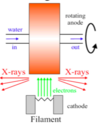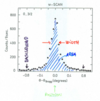Condensed Matter Physics Flashcards
(85 cards)
How do you find the volume of the primitive cell?
- Need the primitive translation vectors of the crystal lattice a1, a2, a3

How do you find the primitive translation vectors of the reciprocal lattice b1, b2, b3?

What is the structure factor?
- fj is the atomic form factor
- generally for the basis, f is used for the form factor of the atom (that is identical in the basis)
- xj, yj, zj are the posns in the basis of the idential atoms
- e.g. for the bcc basis atoms are identical at 0, 0, 0 and 1/2, 1/2, 1/2
- so S(v1v2v3) = f{1 + exp[-π(v1+v2+v3)]}

How do you calculate the structure factor for a certain structure?
What is the atomic form factor?
What is the atomic form factor if charge distribution is spherically symmetrical about the origin?
How to calculate the interplanar distance?
What is the equation for electric conductivity?
Why is the KE of a free e- at corner of first zone higher than that of an e- at midpoint of a side face of the zone in 2D? By what factor is it higher? And what is the factor in 3D?
How do you calculate the Fermi energy and density of states of a free e- gas in 1D and 2D?
What are the energy eigenvalues of a 3D gas of free e-s at 0K?
What is the relation connecting pressure and volume of an e- gas at 0K?
What are 2 ways of entering reciprocal space?
- diffraction
- Fourier analysis
What is Bragg’s law?

How do energies of photon, neutron and electron compare? And what does wavelength vs energy graph look like?
- photon energy = keV
- neutron energy = 0.01 eV
- e- = 100 eV

What is extinction?

What is a Brillouin zones?
What is spallation?
- fast protons e.g. 1 GeV approaching Pb
- intra-nuclear cascade with cascading particles then inter-nuclear cascade
- or highly excited nucleus
- then evaporation
- [still don’t really know what this is]
What is fission? Why are neutrons used? [don’t know why there are words listed under neutrons]
- neutron hits 235 U then fission of excited nucleus
- chain reaction by moderated nucleus
- neutrons
- light elements
- magnetism
- high penetration
- dynamics
What is a coolidge tube?

What is a rotating anode?

What is a Synchrotron?

What is brilliance in X-ray? And Moore’s law?
What do the width, area, position and background of a counts vs θ-θBragg show?
- posn => unit cell
- area, intensity => atomic arrangement
- width => corrections
- background => defects









































